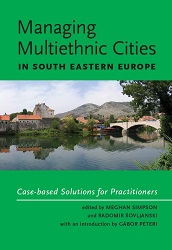City Triangles in South Eastern Europe
City Triangles in South Eastern Europe
Author(s): Gábor Péteri
Subject(s): Politics / Political Sciences, Politics, Civil Society, International relations/trade, Inter-Ethnic Relations, Geopolitics
Published by: Centar za regionalizam
Keywords: Cross-border Cooperation; City Triangles; South Eastern Europe
Summary/Abstract: This introductory chapter on city triangles in South Eastern Europe discusses how, despite the legacy and consequences of the Balkan wars of the 1990s, these cities managed to formalize their contacts in order to resolve their common problems and to remain home to ethnically diverse and recently divided populations. These city triangles handled relatively soft issues like cultural and sporting events, while also tackling issues like business development and questions of water supply. Their attempts at regional cooperation and diplomacy fluctuated in intensity, as political instability in the aftermath of the war often was an impediment to accomplishing much change. Local leaders had to find their local counterparts across what had most recently been a hostile border, while also seeking allies at the national level, more often than not a source of obstruction on the part of politicians and the central bureaucracy. Upon signing the Agreement on Interethnic Tolerance, local leaders were obliged to consider the prospects for concrete cooperation with one another. The struggle to develop, implement and reestablish diplomacy, trade and cooperation indicates that the process of cooperation is as important as the results, whereby citizens come to realize that it is possible to return to peaceful coexistence. The backbone of this effort has been the work of NGOs and a few particularly dedicated individuals to reestablish and continue the ties broken by war between regional cities of the former Yugoslavia. Designed to allow NGOs in member cities to maintain cooperation, even if political circumstances may prevent the respective city administrations from doing so, these triangles have been important channels for keeping communication open and achieving their goals as the nearest opportunity. The first triangle established among Baja, Osijek, and Sombor in 1999 has since been the model for more cooperation among cities in the greater region. Far from their respective capitals, these border cities often have suffered from a dramatic economic decline due to the newly-erected borders and barriers to trade and dialogue and solving common problems like fire protection, waste disposal, water supply, minority rights, or promoting tourism and local economic development. Sustained so far by ambitions to join the European Union and supported under the Instruments of Pre-Accession (IPA), the future for city triangle diplomacy is bright, so long as the incentives remain to forget the hostilities of the past.
Book: Managing Multiethnic Cities in South Eastern Europe - Case-based Solutions for Practitioners
- Page Range: 74-85
- Page Count: 12
- Publication Year: 2010
- Language: English
- Content File-PDF

